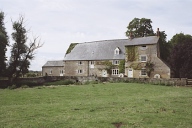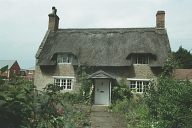Tallington Mill was one of the many mills referred to by the original petition in 1571 by Stamford Corporation, as being to blame for the River Welland being unnavigable. To the east of the village, it was within a short distance of the canal which would surely have been used to transport goods to and from the watermill. A map pre-dating the Enclosure award, possibly drawn by the same surveyors between 1801 and 1813, and in the Cragg deposit at Lincolnshire Archives, shows clearly the direct access to the canal enjoyed by Tallington Mill. The track that now forms the road access led straight to the south bank of the canal, where the towpath was. Access to the mill by road was not the right angled bend that is now, but due south from Mill Lane.
Boat Bank Cottage, of which little remains, was evidently associated with the canal, judging by its name alone. It was in the grounds of Home Farm at the western end of the village. In 1919 the cottage was part of Lot 4 in the sale of the Lindsey estate, but the catalogue gives no more details apart from saying it had “Good gardens”! Is this the same property referred to by local people as the Lock Keeper’s house?
The Crooked Billet, the thatched cottage to the north of St Lawrence’s Church, was once an inn and likely to have been a place where watermen would have stopped off for liquid refreshment, as the canal ran across the northern edge of the property. Once owned by the Casewick estate, and now in private ownership, the building is Grade 2 listed.
I
Ivy Cottage in Mill Lane, with the canal immediately to the south, was originally owned by the coal merchants Ellis and Everard. Coal would have been unloaded straight onto their wharf from the canal lighters on their way upstream. Ellis and Everard moved their operations to the area by the railway station, on the north side of the Stamford Road, when the railway was opened in the 1850s. It was cheaper and more convenient to transport coal by train. Proposals for a new cut, from the point where the railway crossed over the canal to Tallington station on the north side of the main road, raises the question whether it was intended to continue to use the canal as the main method for bringing in coal from the east coast and transfer it to the railway. Alternatively, maybe it was the intention to bring coal to Tallington by rail and transfer it to the canal for conveyance to the east and west.
Blacksmith’s cottage with forge, on the main road just to the east of Bainton Road turning, the blacksmith’s forge would have been within a short distance from the canal, and convenient for the replacement of horsehoes on the boathorses. It was listed as Lot 10 in the sale of the Lindsey estate in 1919, but unfortunately no details were described.
“Herbage” The canal was still apparently a source of income in 1866; the Welland Navigation Committee minutes record that it was “ordered that Mr Cunnington of Tallington be allowed the herbage of the banks of the canal from the Uffington Cow Pasture to the Railway Bridge below Tallington upon the payment of three guineas”!



My dad, Charles Colin Goodliffe, was born in the lock keepers cottage in 1937.